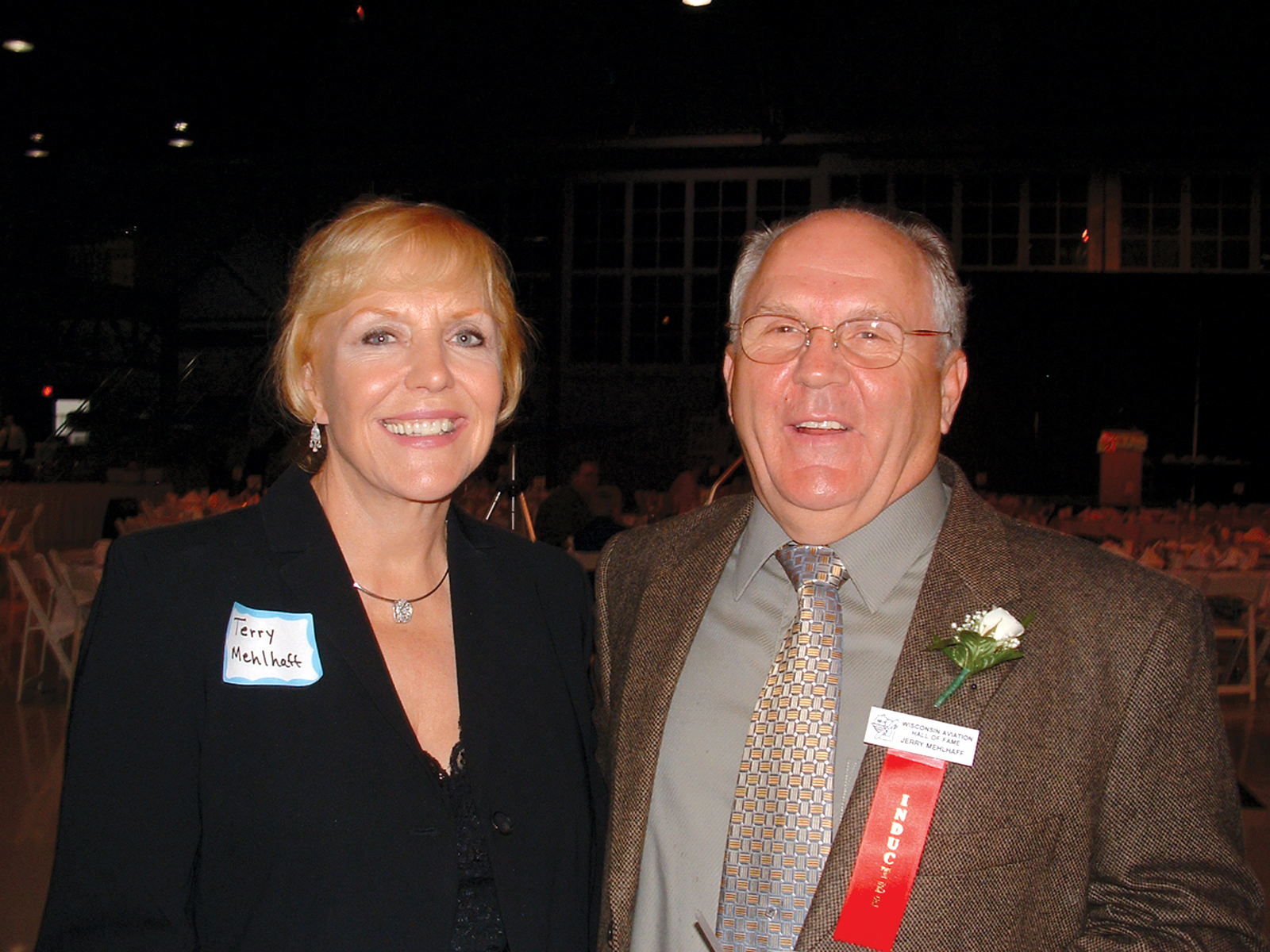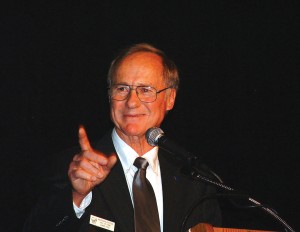By Rose Dorcey
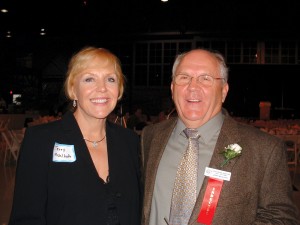
Jerry Mehlhaff was joined by his wife Terry in celebrating his induction into the Wisconsin Aviation Hall of Fame.
Five Wisconsin aviators were recently inducted into the Wisconsin Aviation Hall of Fame. The ceremony took place at the EAA AirVenture Museum in Oshkosh on October 22. Duane Esse, Jerry Mehlhaff, Anton Brotz, Carlyle Godske and Wendell McEldowney were honored for their accomplishments. McEldowney and Godske were inducted in the Pioneer category, for those who made achievements in aviation before 1927.
Jerry Mehlhaff
Jerry Mehlhaff is a South Dakota native, born in 1942 and raised in Franklin, Wis. He soloed and earned his private pilot certificate in 1962. He joined the U.S. Navy just as the United States escalated its involvement in Vietnam, and served a tour of duty on an aircraft carrier.
Mehlhaff returned to the U.S. in 1967, and became a flight instructor. In 1969, he began a career in aviation by purchasing a 200-acre farm near Rochester, Wis., and turning it into an airport. He acquired dealerships for Piper, Mooney and Bellanca aircraft. He also managed Burlington Municipal Airport.
In 1988, he purchased the type certificates for Champion Aircraft Models 7, 8 and 11 and began supplying parts to Champions in service at the time. He started work on and created his patented metal spar wing for the Champion 8KCAB Decathlon; it was certified in 1990. He then introduced the Champion Scout, Explorer, Citabria, Aurora, Adventurer and other aircraft. To date, his company, American Champion Aircraft Corporation, has produced over 6,000 aircraft of all models.
Mehlhaff summarized his approach to aviation when he said, “To start with a piece of fabric and a raw tube and to assemble it and watch it fly away, that’s a real feeling of accomplishment.”
Duane Esse
A busload of family and friends joined Duane Esse in celebrating his induction into the Wisconsin Aviation Hall of Fame. Esse began his distinguished career in aviation education as a middle school science teacher in 1962, where he used principles of flight and aerial field trips to teach science, geography and geology. He then developed a high school aviation course that attracted students from other districts and became a demonstration program for high schools across the country.
In 1971, the Wisconsin Aeronautics Bureau named Esse chief of safety. There, he created and perfected safety training for pilots of all aircraft, from jets to ultralights. He developed a refresher course for flight instructors, conducted countless workshops and seminars, and created what became a model program to improve flight instruction that has been adopted by many other states.
In 1990, Esse developed the aviation career education program to encourage and train minority high school students for careers in aviation. He’s a nationally recognized leader in the fields of flight instruction and safety training. He’s received numerous awards, including the FAA’s National Educator Award, the Distinguished Service Award of the National Association of State Aviation Officials and EAA’s National Aviation Educator of the Year Award.
An aircraft restorer and home-builder, Esse was a founding member, secretary and board member of the Wisconsin Aviation Hall of Fame.
Anton Brotz
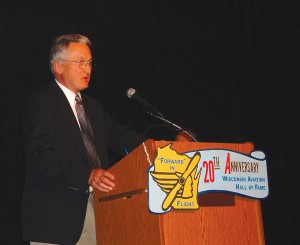
Phil Waitkus, grandson of Anton Brotz, was honored by his grandfather’s induction into the Wisconsin Aviation Hall of Fame. Brotz is known as the “founding father of aviation” in Sheboygan County, Wisconsin.
Anton Brotz was a born mechanic, technician and engineer who spent his entire working life in the engineering department of the Kohler Corp. Born in Sheboygan, Brotz had his first look at a flying machine when famed aviator Lincoln Beachey brought the first airplane to Sheboygan in 1912. A decade later, at age 44, Brotz completed pilot training in Chicago, brought home his first airplane–a war-surplus Standard–and established Sheboygan’s first airport.
In 1927, he accepted the invitation of Walter Kohler to develop an airport in the village of Kohler and advised on the purchase of a Ryan Brougham airplane that helped elect Kohler as “The Flying Governor” of Wisconsin in 1928. When Brotz’ son-in-law Felix Waitkus made a successful attempt to fly his Lockheed Vega solo across the Atlantic, Brotz prepared the plane for the flight in Kohler.
He retired from aviation when the Kohler Airport closed in 1936, and died in 1945. He’s remembered as the founding father of aviation in the Sheboygan area and of a family of aviators whose accomplishments he inspired.
Carlyle Godske
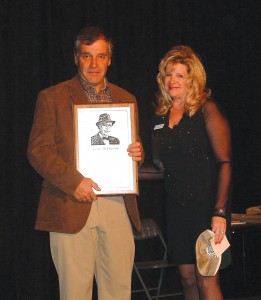
Dale Bahr gratefully accepts a plaque from Wisconsin Aviation Hall of Fame President Rose Dorcey. Bahr is the grandson of 2005 Inductee Wendell McEldowney. A plaque is presented to the inductees or their families, while another is permanently displayed at
Carlyle Godske learned to fly after he returned home from World War I. Born in Racine, he became known as “Racine’s first pilot.” In 1927, he took part in Wisconsin’s first American Legion Air Tour and nearly single-handedly rescued the event after a fatal accident and the Great Depression forced its cancellation in 1932. Dedicated to promoting airport development throughout the state of Wisconsin, the tour was the largest annual aviation event in the state in the 1930s and early 1940s.
Godske started Racine Flying Service at his own landing strip near Sturtevant in 1932, and trained hundreds of pilots from all over the state, including the young Sam Johnson, of SC Johnson Wax Corp. On the eve of World War II, Godske joined other area businessmen to develop the acreage that became John H Batten Airport (Racine-Horlick). He used the new field to start a Civilian Pilot Training program, where he prepared new pilots for military duty. He served as airport manager until 1949.
As World War II was drawing to a close, Wisconsin made plans to accommodate an expanded role for aviation in the postwar years. To chart that future, Governor Walter Goodland appointed a 28-member Special Aviation Advisory Board, chaired by Carlyle Godske. The board recommended that Wisconsin create an aeronautics commission with real power to use state resources to develop and regulate aviation in Wisconsin. The Wisconsin Aeronautics Commission as envisioned by Godske’s advisory board was created on May 10, 1945, two days after the war ended in Europe.
Godske turned his efforts to his family business, but retained his lifelong dedication to aviation. He died in 1988.
Wendell McEldowney
Wendell McEldowney was a young man of 21 when Hugh Robinson became the first person to fly an airplane down the Mississippi River Valley in 1911. Five years later, McEldowney and two of his West Salem neighbors built their own copy of a Curtiss “pusher” and flew it over the bluffs and coulees of La Crosse County.
An automobile dealer and vegetable farmer, McEldowney believed in the future of aviation. In 1913, he purchased stock in the ill-fated Lawson Airplane Company, the pioneering builder of commercial airliners in Milwaukee.
A tireless booster of aviation in western Wisconsin, McEldowney pioneered the use of aircraft in vegetable farming and produced the Aviator brand of canned peas. He established and led the La Crosse wing of the Civil Air Patrol from 1942 to 1954, and worked in the 1930s and 1940s to site the La Crosse airport on French Island, where it remains to this day. McEldowney was recognized for his efforts on behalf of aviation by community, business and government leaders.
McEldowney died in 1964. Frank Muth, longtime La Crosse Municipal Airport manager, best summarized his contribution.
“I know of no one who has given more in time and effort to a dedicated goal than Wendell McEldowney, or who has received less in material gain,” he said. “His only reward has been the satisfaction of witnessing the progress of aviation.”
The mission of the Wisconsin Aviation Hall of Fame is to collect and preserve the history of aviation in Wisconsin, recognize those who made that history, inform others of it, and promote aviation education to future generations. For more information on the Wisconsin Aviation Hall of Fame, call 715-421-0055, or visit [http://www.aviationhalloffamewisconsin.com].











